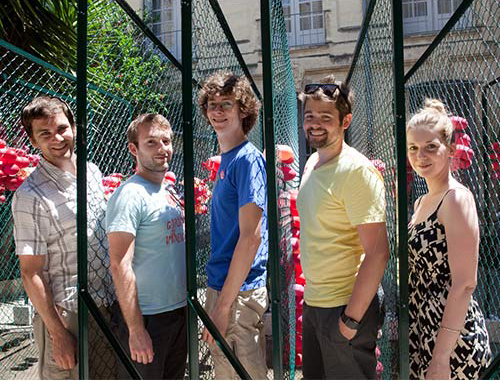PLUX.5 - M. Charbonneau & O. Bourgeois & J-B Morissette & J-P Saucier & E. Bernier
Quebec // Canada
Plux.5 est un collectif formé de cinq diplômés de l’École d’architecture de l’Université Laval, qui cherche à diluer la limite entre le paysage, l’urbain, l’art, le média et l’architecture. Leurs talents et leur passion à travers leurs profils variés, qui nourrissent leurs travaux individuels ou de collaboration leur ont aussi valu de nombreuses reconnaissances scolaires et professionnelles, à l’échelle provinciale et nationale.
Plux.5 is a collective is trained by five diplomas of the School of architecture of the University Laval, which unite in a variable way trying to dilute the limit between the landscape, the urban, the art, the media and the architecture. Their talents and their passion and distinguishing itself through their varied profiles, which enrich their individual works or of collaboration were worth to them in the same way numerous school and professional gratitude’s, in the provincial and national scale.
Plux.5 is a collective is trained by five diplomas of the School of architecture of the University Laval, which unite in a variable way trying to dilute the limit between the landscape, the urban, the art, the media and the architecture. Their talents and their passion and distinguishing itself through their varied profiles, which enrich their individual works or of collaboration were worth to them in the same way numerous school and professional gratitude’s, in the provincial and national scale.

Avec « Ma cour dans ta cour », Plux.5 explore la rencontre entre la cour montpelliéraine et l’allégorie de la cour québécoise au travers de ses archétypes. Dans un jeu de cour où les trames pragmatiques s’opposent au ludique, les « ballones d’eau » (bombe d’eau en ballon de baudruche) s’enchevêtrent dans une « clôture frost », maillage à simple torsion. L’alliance surprenante entre les membranes d’un rouge éclatant et la maille d’acier monochrome prend place dans le contexte étranger de la cour montpelliéraine. Ma cour dans ta cour fonctionne telle une métaphore des vastes territoires naturels domestiqués par la cour intérieure, minérale, régulière et contiguë. Le symbole exogène se démarque du lieu d’accueil et permet la rencontre des cours et des contextes dans un nouvel espace hybride. A l’échelle de la macrostructure, l’installation offre au visiteur une superposition d’images, un croisement des réalités perceptibles. Lorsque l’observateur franchit la porte, le caribou, symbole québécois, apparaît. Puis, lorsqu’il flâne dans la cour, l’échelle microscopique de l’installation se révèle : l’image s’efface, l’assemblage se découvre, l’abstraction s’inverse. La matérialité de l’installation revêt alors une dimension sensible, se comprend comme stratification d’entités qui se déplient et s’ouvrent à l’imaginaire. « (…) Plus les rapports des deux réalités rapprochées sont lointains et justes, plus l’image sera forte, plus elle aura de puissance émotive et de réalité poétique ». Pierre Reverdy, Le gant de crin, 1927.
With « Ma cour dans ta cour », Plux.5 investigate the encounter between the courtyard of Montpellier and the allegory of the Quebecois courtyard through its archetypes. In a courtyard game where the pragmatic pattern is opposing to the playful, “the waters balloons” becomes muddled in the “close frost” (simple meshing twisting). The surprising alliance between membranes of a brilliant red and a steel monochromatic meshing takes place in the foreign context of a Montpellier courtyard. Ma cour dans ta cour works such a metaphor of the vast natural territories domesticated by the mineral, regular inner and contiguous courtyard .The exogenous symbol of the place distances itself, allowing the encounter of the courtyards and the contexts in a new hybrid space. On a macrostructure scale, the installation offers to the visitor a superposition of pictures, a crossing of perceptible realities. When the visitor crosses the hall, the moose, Quebecois symbol, appears. But when the visitor strolls in the courtyard, the microstructure scale shows itself: the abstraction is reversed, the image fades and the assembly confides. The materialism of the installation then takes a sensitive dimension, a stratification, of entities in suspension, which unfold and open in the imagination. « (…) The more the reports of both moved closer realities are distant and right, the more the image will be strong, more it will have of power emotional person and of poetic reality ». Pierre Reverdy,, The massage glove, on 1927.


